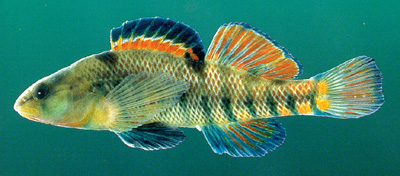Form and Function
All darter species have been divided into two genera:
Percina and Etheostoma. There are many differences
between these groups, the most prominent being size, the
presence of scales on the bellies, and the swim bladder. The
rainbow darter belongs to the genus Etheostoma, meaning
they are typically smaller in size. They also lack the scales
and the swim bladder. This lack of
swim bladder, a gas-filled sac, is an important
characteristic of the rainbow darter because this allows them to
remain at the bottom of their habitat without rising to the
surface.
In a study published in the Ecology of Freshwater Fish,
biologists compared the body types of three species of darters
including Etheostoma caeruleum, E. stigmaeum,
and E. nigrum. The characteristics that they focused on
were preanal length, head length, maximum depth, caudal peduncle
depth, and snout length. What they found was that when compared
to the other two species, E. caeruleum had a much greater body
depth and caudal peduncle depth.It mentions that this body depth
and caudal peduncle depth has an association with the rainbow
darter living in the fast-moving riffles (Guill,
Hood, and Heins, 2003).
It is thought that the darter got its common name from the
darting movement it makes when swimming. To maintain stationary
in the fast moving riffles, rainbow darters hide behind larger
rocks on the bottom of the bed or use its pectoral fins against
rock surfaces. When feeding however, rainbow darters move to the
surface with a movement known as "pecking." The most common food
sources for this species includes chironomid larvae, Mayfly and
caddisfly larvae, small gastropods, and other midge larvae (Schlosser
and Toth, 1984).
Etheostoma caeruleum is a small species of fish that can grow up to three inches in length. The rainbow darter is one of the most brightly colored and recognizable species of darters with the males being brighter than the females. Males are typically identified by their olive green in color with blue and orange striping pattern that becomes more visible during mating season. The females are much darker in color, usually a green-brown with darker brown markings. The dorsal and anal fins of the rainbow darter follow the same coloring patterns depending whether it is male or female. Another characteristic of their coloring is the appearance of three dark spots on their back for both sexes. For an image of a female rainbow darter, visit the USGS Website.
Rainbow darters are heavily used in environmental monitoring programs because hey require clean and clear water along with a coarse bottom layer for reproduction. This species is highly sensitive to poor water quality, pollution, and habitat disturbances so it is commonly thought of as an environmental indicator. If their habitat is disturbed, Etheostoma caeruleum is usually the first species to disappear (Tonnis 2006).
Next, read about the reproduction of rainbow darters, or revisit the home page.
